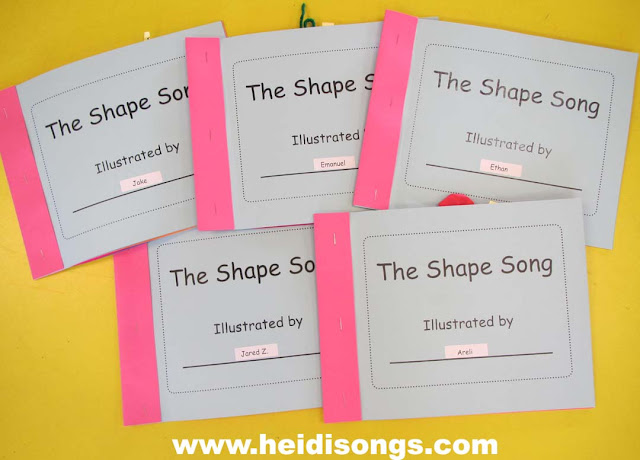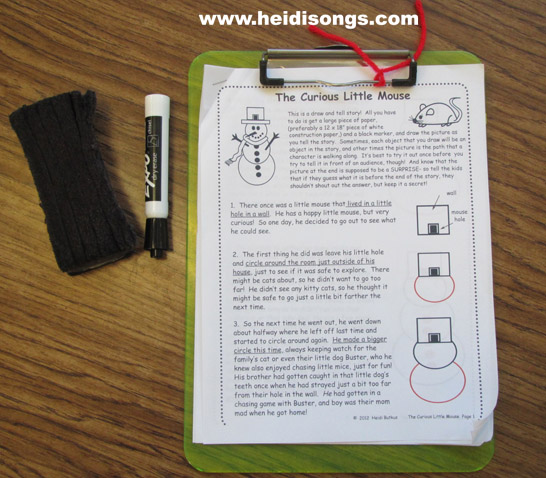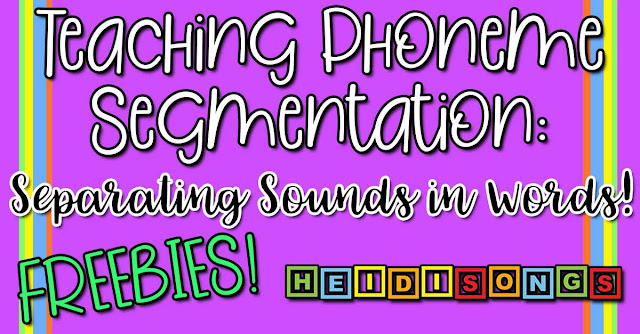How to Do Guided Reading with Children that Cannot Yet Read
Have you heard the news? We've Moved to HeidiSongs.tv!
Our new website features an online video streaming service, updated blog posts at Heidisongs.blog, and a wealth of fresh resources designed to make learning even more fun and engaging.
You can also continue shopping for our educational products there and at our Teachers Pay Teachers store!
Head over to HeidiSongs.tv now and explore all the exciting new features.
See you there!
__________________________________________________________________________
Doing guided reading with emergent readers (children that are not yet really reading) is not hard once you have a few tricks up your sleeve. I have always done guided reading groups in Kindergarten, whether or not my students were able to actually "read" in the technical sense. There are many vital skills that emergent readers can learn from a lesson in guided reading, too! You are probably already doing many of these things with your students already, and just didn't know that these things could actually fall under the umbrella of a guided reading lesson.
The first thing to do is to find a set of books that are predictable and easy to read, and use those for your lesson. What you really want your students to do is to go through the motions of being readers, even though they are really just pretending. Many of these books can be printed off the internet without purchasing a thing, just like the one in the picture below. You can download that one here.
Or this one here. I call it the "I See" book! Super cute, simple, and FREE here!
Some other examples of some predictable books that could be used would be Mrs. Wishy Washy by Joy Cowley and Brown Bear, Brown Bear by Bill Martin, Jr. Here is a picture of some other books that we have in our classroom that we use for guided reading with our students that cannot yet really read. Here is a blog post that I did that includes a list of my recommendations for the best free and paid emergent reader books as well!

Emergent readers are patterned books with easy, predictable text.
Books that work well for a guided reading lesson for emergent readers tend to be so easy that young children can usually listen to them once, and then they could probably just about "read them" themselves! Of course, they really have them memorized, but that doesn't matter much. They are still learning about how print works as they pretend to read the books.

Books that work well for a guided reading lesson for emergent readers tend to be so easy that young children can usually listen to them once, and then they could probably just about "read them" themselves! Of course, they really have them memorized, but that doesn't matter much. They are still learning about how print works as they pretend to read the books.
Repetition like this is good for kids because it helps kids develop their memory, and helps them learn to predict events in a story. Pausing to ask children what they think is going to happen next is a great thing to do in stories, even simple stories like this, and increases their confidence as readers! You can also do sequencing activities with stories like this if you can find simple pictures of the stories, or if you have some extra copies of the book. Just take the book apart and use the pages as pictures. Have the children put them back in order, using the words first, second, third, last, etc. All of these activities are great for building language and communication skills for little ones. And using non-fiction books, especially, helps build their knowledge base too.
This is what I usually do when I teach a Guided Reading group to emergent readers.
1. Read the book aloud to the children.
2. Read the book aloud again, leaving out certain words as you go along.
Tell them that you are going to leave out some words as you read, and they are going to look at the pictures and see if they can guess what word it is. As you touch those words, just don't say them and then have the children try to predict what words they are.
3. Now read it again, covering up the pictures as you go along.
Or even better, switch to reading off of a pocket chart if you can. Tell the children that as you read, you are going to let them guess the missing words, but this time they will use the first letters of the words as a clue to figure out the missing word. (Taking the words off of the pocket chart and rebuilding the story is another great extension to this lesson, but that would probably need to be done on another day.)

4. Then pass out your student books and review the parts of the book with your group.
I always first show them mine, and then have them touch theirs, repeating the name of the part of the book. We include the following items: front cover, back cover, title, title page, author & illustrator (and their jobs.) Sometimes I reference the picture cards in the Concepts of Print Bingo game for the kids so that they will be ready to play the game as a review on another day.
5. Have the children count the words in the title, and then count the letters in the title.
Then we read the title together, and then turn to the title page and read it again. Then we turn to where the story begins, and turn the page. I tell the children to all put their finger up in the air and hold it there when they have got the page turned and are ready. Once everyone has gotten that page turned, then we are ready to begin.
6. When I say, "Ready, read," then the children all try to read the first sentence together with me, as best they can remember it, pointing to each word as we go along.
Remember, most (if not all) of the children really can't read at all, but we are talking about a VERY simple story with repetitive, predictable text that they should have now heard three times. So they should mostly have the story memorized at this point. I turn my book around so that if they are looking at it, it is turned the correct direction from them. I just look over the top of my book and read it upside down as I model how to track each word.
7. As we read, I try to teach them to track (touch) each word, going from left to right.
We talk about the return sweep (going from the end of one line at the right side of the page to the next line below it on the left.) I teach them about word boundaries, and we count the words and sentences on many of the pages. There is usually not enough time to count the words and sentences on every page. Children that do not recognize word boundaries often have no idea which word to point to, and make quick left/right motions with their hands as they pretend to point to the words and read the sentence. When children track words on a page as they are learning to read, they are starting to connect letters and words to sounds; this is incredibly important for them on their journey to become real readers.
8. If your kids know any sight words or any other words, then I would look for those sight words on every page. My kids sing the sight word song associated with that word, too!
If you are working on a printable book, then consider letting them find and color those certain words as you see in the photo below. This really helps them find the word boundaries as well. We did this a LOT and I think it made a HUGE difference to my students! It is also a nice because I can get everyone started, and then stop one child from coloring and have him or her read me the whole little book individually. After that, I stop the next child and have HIM read to me, etc. As for the sight word songs are concerned, when we find those words that we know, we ALWAYS stop and sing them together just acapella, (without a CD or DVD) right there at the reading table. I think it really helps them connect the song to print in their minds. (See the video of one of my sight word songs below.)

9. Be sure to ask questions about what is happening in the story as you go along and when you are finished reading it. You don't want to forget to address comprehension!
Make sure that you ask them their opinion of the story when you are done, too.
10. Once we have done all of this together, I let them read the story by themselves, and then read it to the person sitting next to them, if there is still time.
11. Ideally, I think it is best if the children can take the book home to read it to their parents as well, but not every teacher has a lending library!
Paper copies of the books, though, are sometimes possible to give to children. Just make sure that you include the reading of the book to their parents in your homework assignments. Some parents might not think about asking their children to read the little books their kids bring home, and it's a good reminder to them to listen to their children read ask questions about the text.
As your students learn the different strategies for reading, you may want to add each of them to a poster or something like that, especially if your administration is looking for "proof" on the walls that this type of instruction is happening. For more info on reading strategies that work well with young children, check out Vanessa Levin's Pre-K Pages blog post on Reading Strategies. Here are the guided reading strategies used most often by primary teachers.
Strategies to Use When Children Come to an Unknown Word
1. Sound it out.
2. Look for picture clues.
3. Skip it.
4. Look for chunks.
5. After you've tried to read a word, ask yourself, "Does this make sense?"
If you don't have a set of "predictable books" that you could use, you might consider having the kids make their own "Singable Book." We have these projects on our website, such as the Shape Book on the Printable Projects CD-Rom, with the music on Little Songs for Language Arts DVD and CD. They work on the book one page a day as an art project, and each day, as I demonstrate how to do the book, we sing the little song. By the time they are done, they already know it. Then we spend one day doing guided reading on it when the books are all completed. The biggest issue is that anyone who is absent will need to make up that page, because everyone has to complete every single page, no matter what- or you can't do that guided reading lesson with them all. (On the other hand, I do keep extra teacher samples on hand from previous years, so that if I wind up with a kid that didn't quite finish a page, I can hand him or her my book to use for the moment.)

Guided Reading is generally done in small groups, which means that you will need something to keep the rest of your students busy by themselves while you work with a few of them. If you don't have any little literacy center activities ready to go, then you can do the Daily Five while your kids are in groups. BUT, you can also do a combination of Daily Five things and literacy centers. OR, you can even take the easy route and do some worksheets while you prepare literacy centers and build up your supply of literacy centers, little by little. It's not so bad, if you know that you can fall back on some worksheet-y types of things when you don't have anything better available. I think that the very easiest thing to do is put those worksheets into page protectors and give the kids dry erase markers. You can put out a whole bunch of them and let your high kids really do as many of them as they like! I have to say that the top half of my kids absolutely LOVE this! The bottom quarter- well, not so much! With them, I have to insist that they finish ONE and then save it, and bring it to show me when they are done. If they "forget" and erase it, then they can complete it later at playtime. (Oops!) Once we have been through that, it usually doesn't happen twice! (But if it does, then that child always gets paper and pencil.) I know that worksheets are NOT developmentally appropriate, and are not the best way to learn. BUT- as a matter of survival for a teacher that has no better alternative prepared, it will have to do. Plus, if you put them in page protectors and then erase them, you barely have to copy a thing, and you won't have to correct ANYTHING!

There are several sight words worksheet books on my website that I developed for this purpose, and we also have a set now with hidden sight words (see below) in them! (I also use them regularly for homework.) There are WAY more worksheets that anyone would ever want to give their kids, but what I do is put them in page protectors and let the kids go! We do them about once a week that way, usually. I also give them to my high kids if they finish a task early or master a skill really early on, and don't need to do a lesson. I prefer to give them an iPad, but if the iPads are being used for some other lesson, then it's good to have an alternative.
Ideally, it's best to leave a copy of the books that your kids learned to read in a reading center so that they can go back to them often and re-read them. But since I send my books home with the children as part of their reading homework, I usually need to keep careful track of every single one of them, so I generally do not have enough copies to put an extra in our reading center. Later in the year, I try to remember to get them out and let them read the books again for fun and practice. We often also give the children Accelerated Reader tests on the books that they have learned to read in my Guided Reading groups, too. If there is not an existing test, then I can always write my own!
Here are some more blogs that also focus on Kindergarten readiness. Check out this post. It gives you lots of other blogs to look at for other great ideas.
P.S. Don't forget all our videos are available to STREAM on UScreen, FREE for the first 30 days! It's an awesome way to bring some EASY, active learning to your students during this time, and they can always cancel right before they are ever charged, like on day 29! Check out the info page on our website for more info!
----------------------------------
Follow me! Did you enjoy this post? Do me a favor and share it with your friends! And follow this blog by signing up for my email updates here, and follow me on TPT! I'm also on Pinterest, Facebook, Twitter, Instagram, and YouTube, too! Don't forget to sign up for our email newsletter for special deals and promo codes that you won't find out about anywhere else.


















